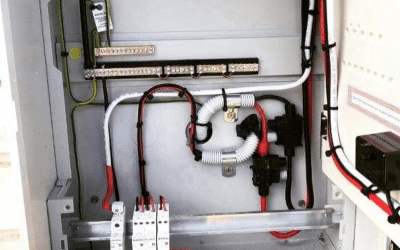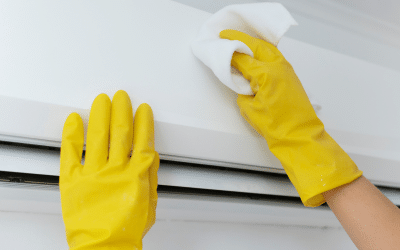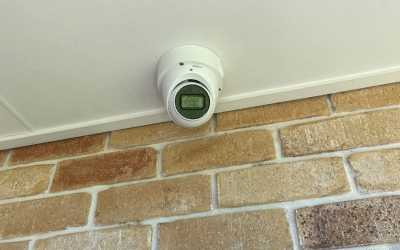While air conditioning used to be seen as a mod con and a bit of a luxury, it’s now a staple of the Australian household – with an estimated 80% of homes having AC systems.
Unfortunately, it isn’t until our AC starts to falter – or stops working altogether – that we realise just how essential it is to our comfort and well-being. Worse still – issues with our AC seemingly come out of nowhere and at the most inconvenient times.
Now, for many AC problems, the simplest solution would be to call an AC repair company – and, often, it’s the only solution. Fortunately, however, you may be able to resolve some air conditioner problems yourself, saving you both time and money.
So, with that in mind, let’s look at the most common air conditioner problems and solutions.
Why is My AC Not Working At All?
Let’s start with the most pressing and significant problem: your AC system not working at all. As you’ll see, many AC problems are interconnected and failing to address one issue can cause, or worsen, others – resulting in your AC system not working altogether.
List of the Possible Causes of AC Not Working
- Your AC System is Switched Off: The simplest reason for your AC not working at all is that it’s turned off. Some people turn off their AC system, for example, when leaving for vacation and forget to turn it back on. Alternatively, if you didn’t turn it off yourself, someone else in your household may have.
- Thermostat Issues: Your AC unit could fail to start as a result of a thermostat malfunction. Your thermostat settings tell the AC system when, and how long, to run, so if it’s faulty, your AC may also fail to work properly. Possible reasons for a thermostat malfunction include:
- Incorrect settings
- Dead batteries
- Loose wires or screws
- Built-up dust, grime, and corrosion
- If the thermostat is directly placed in the path of sunlight (affecting its temperature reading)
- Improper temperature calibration
- Low Refrigerant: Refrigerant, or Freon, is a liquid that’s dispersed around your home as a gas to cool and dehumidify the air. If your AC system is low on refrigerant, typically as a result of a leak, it can result in malfunction.
- Dirty Condenser Coil: Every AC system has two coils that pass refrigerant between them to cool the air. The evaporator coil is found inside the indoor unit of the AC system, which takes refrigerant and turns it into gas. The refrigerant then absorbs the heat from the air and sends it to the outdoor unit. In contrast, the outdoor part of your AC system contains a condenser coil that takes the hot refrigerant from inside your home, cools it down, and redistributes it.
Over time, and especially if your outdoor unit isn’t regularly maintained, the condenser coil can accumulate dirt and grime over time. As a result, it will have to work harder to cool down collected refrigerant. This could cause it to overheat, which could trip your home’s circuit breaker or, worse, significantly damage the outdoor unit – in either case, your AC system would fail to turn on.
- Clogged Air Filters: Just like dirt build-up on the condenser coil, your AC unit’s air filter becoming clogged can eventually cause the system to stop working altogether. Clogged AC filters restrict airflow, resulting in your AC system working overtime and potentially overheating.
- Outdoor Unit Failure: A common reason for an AC system not working at all is a damaged outdoor unit, which contains several components that work in tandem. This can happen for several reasons:
- The three issues stated above – low refrigerant, clogged filters, and problems with the condenser coil – could all damage the outdoor unit over time.
- Leaves, animal droppings, dirt, and debris can accumulate in and around the outdoor unit, causing it to overheat and eventually fail.
- The capacitor, the component that helps start the motor, is prone to overheating. If the motor malfunctions, the capacitor can overload and the outdoor unit won’t start.
- General wear and tear: consistently switching your AC system on and off can wear out essential components like the compressor, capacitor, motor, and fan.
- Similarly, as components are interconnected, loose, damaged, or corroded wires can result in failure.
- A recent power surge could have damaged the outdoor unit, preventing it from starting.
- Tripped Circuit Breaker: Many of the problems mentioned above, such as dirty coils, clogged air filters, and power surges, can trip one of your home’s circuit breakers. Alternatively, the issue can lie with the circuit breaker itself, such as loose or damaged wires.
Possible Solutions for AC Not Working
Here are some potential fixes for your AC not starting at all. Before attempting any air conditioner troubleshooting, ensure your AC unit is switched off.
- Your AC System is Switched Off: Just like any electrical appliance, an AC system has an on/off switch, which you’ll find close to where your system is installed. If it’s turned off, that’s excellent news – just switch it on and the issue should be resolved!
- Thermostat Issues: Here’s how to deal with various issues related to your thermostat:
- Confirm that it’s configured to the correct settings and your desired temperature.
- Reset the thermostat.
- Replace the batteries.
- Tighten up or reposition any loose wiring or screws
- To deal with accumulated dirt and corrosion, remove the thermostat’s cover and use a soft toothbrush or cloth to gently clean the contacts. You could also carefully slide a sheet of paper behind the contacts to dislodge any settled grime.
- Check the thermostat’s placement: if exposed to direct sunlight, move it to a better-shaded area.
- To check for miscalibration, place a glass thermometer next to your thermostat. After 15 -20 minutes, check the readings on both: if there’s over a degree’s difference, recalibrate the thermostat.
- If the thermostat is too corroded or doesn’t work at all, contact a professional AC repair company to repair or replace it.
- Low Refrigerant: The refrigerant line runs between your AC system’s evaporator coil (indoors) and condenser coil (outdoors). You can get an indication of the refrigerant level by feeling the larger of the two copper lines that go into the outdoor unit: if it’s cold and moist, there is enough refrigerant. However, if not, refrigerant is low.
Although you might see articles and videos instructing you how to refill your refrigerant need to be done by an AC repair service, as doing it incorrectly can damage your AC system. Additionally, low refrigerant levels are likely because of a leak, so you’ll need professional help to locate it and decide whether it’s best to repair it – or if something must be replaced.
- Dirty Condenser Coil: To clean a dirty condenser coil, first consult your AC manufacturer’s instructions to locate it. Typically, this involves carefully removing an access panel from the outdoor unit. Once revealed, it’s possible to clean the coil, again, according to the manufacturer’s recommendations, with compressed air, a special cleaning agent, or even household detergent.
Naturally, if you wouldn’t feel comfortable doing this, you can get an AC maintenance company to do this for you. Also, if the built-up dirt around the coil has led to it becoming non-functional, you’ll have to get it professionally replaced.
- Clogged Air Filters: Fortunately, clogged air filters are another problem you can fix yourself. Simply, open up the AC units in each room, remove their filters, and see if they’re thick with dust and grime. If so, clean them with a vacuum cleaner, shake off the grime outdoors, or gently run them under a hose. If you clean the filters with water, make sure they’re completely dry before reinserting them.
- Outdoor Unit Failure: If your outdoor unit isn’t coming on, it’s best to enlist the services of an AC repair service instead of attempting to tackle it yourself. There’s a chance the failure is due to your AC system nearing the end of its life, so an AC professional will let you know if you’re better off repairing it – or investing in a new one.
- Circuit Breaker: If one of your circuit breakers has been tripped, reset it as follows:
- Switch off your AC and thermostat
- Turn on the circuit breaker
- Wait around 30 minutes, allowing the circuit breaker to reset
- Turn your AC and thermostat back on
- If your AC works again, you’re good to go. If, however, the circuit breaker trips again, leave both the AC and circuit breaker switched off and call an electrician or AC repair company. Crucially, never try to repeatedly reset a circuit breaker that keeps tripping – as you could start a fire.
AC Units are Blowing Hot or Warm Air
Let’s move on to the problem of your AC system blowing hot or warm air and what you can do about it.
List of the Possible Causes of AC Blowing Hot or Warm Air
- Thermostat Issues: Your AC may be blowing warm air due to a misconfigured or defective thermostat. For instance, the blower fan might constantly be on – or the temperature could be set too high!
- Low Refrigerant: If the AC system is low on refrigerant, there may not be enough to sufficiently remove the heat from a room, causing it to blow hot air.
- Damaged Ducts: Leaks in your ductwork could be another reason for your AC blowing hot air. These leaks can be the result of damage from animals (especially rodents and birds), accidental damage during home improvements, poor installation, or general wear and tear. With damaged ducts, some of the cold air generated by the outdoor unit doesn’t make it inside, resulting in warmer air than desired.
- Dirty or Frozen Evaporator Coil: Another common reason for your AC blowing warm air is an issue with the evaporator coil, found within the indoor unit. Firstly, as the evaporator coil removes heat from the room, this often results in condensation. This makes it easier for dust and grime to stick to the coil: the more debris it accumulates, the less it can absorb heated refrigerant and transfer it to the outdoor unit for cooling. Eventually, as a result, your AC unit will start to blow warm air.
Alternatively, accumulated dirt on the coil restricts airflow, preventing absorbed warm air from reaching the refrigerant. This makes the refrigerant too cold and freezes any moisture on the coil – and eventually the coil itself. The frozen coil prevents transfer to the condenser unit – also resulting in the AC blowing hot air. A frozen coil can also be the result of dirty air filters, which restrict airflow in the same way.
- Clogged Air Filters: As well as causing frozen evaporator coils, dirty AC filters can overheat the fan motor in the outdoor unit. Over time, this can make it less efficient or defective, resulting in your AC emitting warm air.
- Problems with Outdoor Unit: A damaged or ineffective outdoor unit is a common reason for AC systems producing warm air. It could be a problem with the compressor, which is responsible for circulating refrigerant. If faulty, cool refrigerant may not reach the indoor unit, so it doesn’t produce cool air. Similarly, there may be a problem with the outdoor unit’s fan, which pushes warm air outside your home. Without it, the AC system’s heat transfer will be insufficient and it won’t be able to produce cool air.

Possible Solutions for AC Blowing Hot or Warm Air
Here are some potential fixes for your AC blowing hot or warm air. Before attempting any air conditoner troubleshooting, ensure your AC unit is switched off.
Thermostat Issues: Verify that your thermostat settings weren’t accidentally switched, and then troubleshoot as described earlier in Possible Solutions for AC Not Working. If your thermostat is malfunctioning or won’t let you change settings, call an AC repair service to look at it.
- Low Refrigerant: Determine if you have low refrigerant levels by touching the refrigerant line as described in Possible Solutions for AC Not Working. If refrigerant levels appear low, call an AC company to refill it.
- Damaged Ducts: First, locate any holes or tears in your ductwork. There are several ways to do this:
- Visually – see if you can actually see any damage. This includes keeping an eye out for existing duct tape or sealant, as it may need to be reapplied.
- Check the joints where two pieces of duct meet, as they’re more likely to suffer damage over time.
- Slowly move a smoke pencil or incense stick along the length of your ductwork; if the smoke moves around more in certain places, that indicates a leak.
Once you find the leaks, seal them with duct tape, metal tape, or mastic sealant. Bear in mind, however, that lots of ductwork is hidden, so if you can’t find the leak, you’ll need the help of an AC repair company to reach the inaccessible sections.
- Dirty or Frozen Evaporator Coil: First, use your AC manufacturer’s instructions to locate the evaporator coil, then reveal and inspect it. If dirty, clean it as recommended. If, on the other hand, the coil is frozen, you can let it thaw by not using your AC for 24 hours to thaw completely. Better still, you can defrost the coil faster by using a hairdryer, but don’t hold it too close to the coil.
- Clogged Air Filters: Remove and clean your filters (see Possible Solutions for AC Not Working for greater detail). Also, if you own a pet, you’ll probably need to change the air filters more often, because of fur.
- Problems with the Outdoor Unit: Check the fan first and see if it’s spinning. If not, remove the outer panel, remove any visible grime or debris, reassemble the unit, and see if your AC is blowing cold air again. If not, call an AC professional, as the problem with the fan could be serious – or the unit could have a faulty compressor, capacitor, or another component that requires their expertise.
Leaking AC Units
Next, let’s look at the problem of a leaking AC unit and possible ways to solve it.
List of the Possible Causes of a Leaking AC Unit
Your AC system can leak water or refrigerant, let’s look at the causes for each.
Possible causes of your AC system leaking water
- Clogged Condensate Drain Line: Your AC system’s condensate drain line runs from the indoor to the outdoor unit, collecting moisture as it dehumidifies your home. While doing so, however, it collects bits of grime; so if the drain line isn’t cleaned on occasion, this compounds and results in a blockage. In time, water will start to pool within the indoor unit, fill the condensate drain pan, and leak out.
- Damaged Condensate Drain Pan: The condensate drain pan sits under the evaporator coil to catch dripping moisture. If the pan becomes damaged or rusted, it will leak water instead of directing it into the drain line.
- Drain Line Disconnect: The drain line can become disconnected, whether from wear and tear over time or poor installation. If this occurs, it will result in a leak.
- Broken Condensate Pump: The condensate pump helps remove water from the indoor unit: particularly if it’s installed in a place where water can’t easily flow out of the drain line. Similarly, another mechanism called a float switch indicates when water reaches a certain level and should be pumped out. If the pump or float switch is broken, water will remain in, and leak out of, the unit.
Possible causes of your AC system leaking refrigerant
- General Wear and Tear: A refrigerant leak can be the result of simple wear and tear. This includes joints and fittings loosening or eroding over time, as well as tiny holes developing in the coils.
- Vibrations: The vibrations caused by the motor in the outdoor unit can weaken refrigerant lines over time – particularly if they weren’t installed well initially. Worse, if the outdoor unit isn’t sealed properly sealed, it vibrates more than normal, increasing the chance of damaging a refrigerant line – as well as other internal components.

Possible Solutions for a Leaking AC Unit
Here are some potential fixes for a leaking AC unit. Before attempting any air conditioner troubleshooting, ensure your AC unit is switched off.
If your AC system is leaking water
- Clogged Condensate Drain Line: First, use the manufacturer’s instructions to locate the drain line and drain pan. After checking the pan for pooled water, check the drain line for blockages and use a wire brush to remove built-up grime. For a significant blockage, an AC technician may have to use a special pump or vacuum to unclog it.
- Damaged Condensate Drain Pan: A cracked if the drain pan is cracked, you can repair it with a water-resistant sealant. If the pan is rusted, on the other hand, you’ll need to replace it. Consult an AC repair company to find the right-sized pan – to prevent further leaks and damage to your AC system.
- Drain Line Disconnect: Reconnecting the drain line will require the expertise of an AC professional.
- Broken Condensate Pump: Similarly, replacing a condensate pump or float switch is the job of a trained AC technician.
If your AC system is leaking refrigerant
As your AC’s piping network is complex – and refrigerant leaks can be dangerous, repairing refrigerant leaks has to be done by an AC repair company. Not only will they be able to find the source of the leak but also determine whether it can be repaired or if piping need replacing.
Uneven Room Temperature
Uneven room temperature is another common sign that your AC system is faulty. Here are some potential causes and fixes.
List of the Possible Causes of Uneven Room Temperature
- Thermostat Issues: Occasionally, a malfunctioning or miscalibrated thermostat can affect airflow and cause uneven room temperatures.
- Clogged Air Filters: If the AC air filters in a particular room are blocked, it can affect the temperature therein – creating warm spots that cool air can’t reach. Not to mention, clogged filters put additional stress on your AC system, which compromises its ability to push out cold air.
- Low Refrigerant: Low refrigerant levels can result in reduced cooling capabilities from your AC – and possibly little to no air coming from AC units.
- Faulty Blower: The blower, found within the indoor unit, is responsible for pushing cold air through ducts and throughout your home. If the blower is compromised or damaged, airflow within the system will decrease, leading to uneven room temperatures.
- Damaged or Blocked Ducts: Tears and cracks in your ductwork can result in reduced airflow, as the cool air escapes before reaching rooms. Additionally, ducts can become blocked with debris and, worse, nests built by rodents and birds, which can impact airflow considerably.
- Clogged Outdoor Unit: Leaves are debris that can easily get stuck in your air If the outdoor unit becomes clogged up with leaves, lawn clippings, and other debris, it will be harder for it to disperse the warm air removed from inside, which will compromise the airflow. Alternatively, a similar thing can happen if bushes or plants are covering the outdoor unit.
- Wear And Tear (Mismatched AC Unit): Unfortunately, it’s entirely possible that you, or your home’s previous owner, bought an AC system that’s too big or small for the house. On one hand, too big an AC system will switch on and off more frequently to maintain your set temperatures. These increases wear and tear and decrease the system’s efficacy, resulting in weaker airflow. On the other, an undersized AC system must work harder to adequately cool your home, overheating its components and causing inconsistent airflow.
Possible Solutions for Uneven Room Temperature
Here are some potential fixes for uneven room temperature. Before attempting any air conditioner troubleshooting, ensure your AC unit is switched off.
- Thermostat Issues: See Possible Solutions For AC Not Working
- Clogged Air Filters: See Possible Solutions For AC Not Working
- Low Refrigerant: See Possible Solutions For AC Not Working
- Faulty Blower: Refer to the manufacturer’s instructions to locate the blower; open the indoor unit and carefully clean off any built-up dirt on the blades (watch your fingers!). If the airflow is still weak afterwards, or the blower doesn’t appear to work at all, call an AC company.
- Damaged or Blocked Ducts: To fix damaged ducts, see Possible Solutions for AC Blowing Hot or Warm Air. For blocked ductwork, ultimately, it’s best to get a professional to take care of it. However, you could find the source of the blockage by checking the airflow coming from individual AC units. If it’s weak or non-existent, compared to others, the ductwork close by is probably blocked.
- Clogged Outdoor Unit: First, remove any plants or shrubbery blocking the outdoor unit. From there, remove any visible leaves, twigs, trimmings, etc., lodged in the outer panel of the unit. To be more thorough, remove the outer panel, and clear any debris that found its way inside the unit. If you notice the coil is dirty, clean it as advised in Possible Solutions for AC Not Working. If this doesn’t make a difference to airflow, get an AC service company to take a look at it.
- Wear And Tear (Mismatched AC Unit): If you suspect your AC is ill-suited to the size of your home, get an AC repair service to come in, access the system, and propose the best solution.
Loud Noises from the AC System
When faulty, your AC system could make different sounds depending on the type of problem. Let’s look at a few reasons why loud noises are coming from your AC.
List of the Possible Causes of Loud Noises Coming From the AC System
- Rattling: Intermittent, rhythmic rattling could indicate a loose air filter.
- Whistling: Whistling noises likely point to damaged ductwork or a blockage within it. Similarly, an obstruction in airflow and the resulting noise could be from clogged air filters.
- Mechanical Noise: Grinding, clicking, screeching, etc. – which we’ve grouped as “mechanical noises”, can signify problems with essential components in the indoor and outdoor unit. More specifically:
- Clicking noises, when turning the AC on or off, could mean something is obstructing the fan or it’s loose. There could also be an issue with the capacitor in the outdoor unit.
- Screeching (from metal scraping against metal) could indicate a mean there’s a faulty belt, fan motor, or compressor.
- Grinding, thumping or banging noises could signify a blower (indoor unit), fans, motor, or compressor.
- Buzzing: Buzzing, or humming, sounds mean a possible electrical issue. This could be due to loose wiring, a faulty motor, or various problems with the compressor – such as an issue with the contractors that provide the compressor with electrical current.
- Bubbling or Hissing: This signifies a refrigerant leak or excess moisture within the system. Hissing could also signify a serious problem with the compressor, like a valve leak or built-up pressure.
Possible Solutions for Loud Noises Coming From the AC System
Here are some potential fixes for loud noises coming from your AC unit. Before attempting any air conditioner troubleshooting, ensure your AC unit is switched off.
- Rattling: Open the AC unit in the room where you hear it rattling and check the filter. If loose, fasten it properly and the noise should stop.
- Whistling: Similarly, if you hear whistling from a particular unit, check the filter and if it’s clogged, clear as advised in Possible Solutions for AC Not Working. If the filter isn’t dirty then the ductwork may be responsible for the whistling. In that scenario, see Possible Solutions for Uneven Room Temperature for advice on blocked or damaged ducts.
- Mechanical Noise: To clear any potential obstructions, open, clear, and clean the outdoor unit (see Possible Solutions for Uneven Room Temperature) or indoor unit (Possible Solutions for AC Blowing Hot or Warm Air). If after clearing all obstructions and cleaning off internal components, the noise persists, call an AC repair company.
- Buzzing: Because of the risk of electric shock that comes with trying to deal with electrical issues yourself, call an AC repair company or reputable electrician to solve the issue.
- Bubbling or Hissing: Whether the noise is from a refrigerant leak or a faulty compressor, it will require the attention of an AC professional.
Unpleasant Odours Coming From AC
Another common, and especially annoying, AC problem is when it produces foul odours. Let’s look at how to address that now.
List of the Possible Causes of Unpleasant Odours Coming From the AC
- A Musty or Damp Smell: This is likely because of mould growth. Although excess moisture should be removed during the cooling process, issues like insufficient airflow and dirty coils mean this isn’t always the case – and mould can develop if left unchecked. Similarly, a damp smell could be due to excess moisture not being drained properly and floating around in your system.
- A Burning Smell: This could signify an electrical fault – and wiring or components overheating.
- A Gas or Skunk-Like Smell: This is most likely because of methyl mercaptan, a gas used in the manufacturer of AC systems. This is a serious issue because, in high doses, it becomes toxic and can cause symptoms like coughing, headaches and dizziness, skin and eye irritation, nausea, and vomiting.
- A Rotten Egg Smell: This could point towards dead animals rotting in your ductwork.
Possible Solutions for Unpleasant Odours from the AC System
The best solution, regardless of the odour, is to call an AC repair company. Firstly, they know how to locate the source of the smell, dismantle your AC system to rectify it, thoroughly clean it (with the right agents), and put the system back together properly. Secondly, because odours are usually symptoms of bigger issues, they’ll make any necessary repairs or replacements.
Also, while all odours are a cause for concern, with a gas or burning smell, you should contact an AC repair service immediately, as both could pose a danger to the people in your household.

Why Should You Address Your AC Problems As Soon As Possible?
While some issues with your AC are significant and demand immediate action (like your AC not working at all), some are minor and allow you to put off calling an AC repair service. However, whether big or small, here are a few key reasons why you should deal with any AC problems as soon as possible.
Improved Efficiency
Regularly cleaning your AC makes it run more efficiently. Built-up dirt and grime stress your AC system, so it has to work harder to cool air and push it out. If your AC starts to experience minor problems, it’s a sign that it needs some maintenance. A thorough clean will not only address those issues but make your AC system run a lot smoother.
Lower Electricity Bills
On a related note, the more inefficient your AC system is, the more power it consumes to run – adding to your electricity bills. When your AC is running more frequently in those sweltering summer months, this can really add up. Subsequently, by quickly addressing small issues that signify your AC unit needs a check-up, you can save on your power bill.
To Avoid Costly Repairs and Replacements
On the subject of saving money, the longer you leave minor issues with your AC, the more likely they are to grow into significant problems. For instance, dirty filters, ductwork, or coils might only cause annoying sounds and a small drop in performance at first. However, if left unchecked such small problems can place so much additional pressure on the AC system that essential components malfunction and have to be repaired or replaced. This will end up costing you far more than fixing the initial minor issues would have.
Better still, in dealing with minor problems, an AC professional could potentially identify other issues before they worsen and present themselves – saving you the money you would have spent on future callouts.
Increased Lifespan
Between running more efficiently and not having to replace its components regularly, addressing issues quickly prolongs the life of your AC unit. The longer its lasts, the more value you derive from the cost of its purchase and maintenance.
Better Indoor Air Quality
Lastly, and most importantly, addressing AC issues as soon as possible allows you to maintain good air quality and avoid the potential health problems that come with breathing in contaminated air. The dirtier and more clogged your AC system becomes, the more dust, mould, and bacteria particles will be blown out into your home. And if dead animals and insects are clogging up your ductwork, you’ll be breathing them in as they decompose!
Fixing AC issues as soon as possible not only benefits the health of your AC system but your own health and that of your loved ones too.

—
We hope this post has given you greater insight into the various problems your air conditioning system can develop, as well as possible methods of solving them before you call an AC repair company.
If your AC develops any issues – or fails to start at all, contact LeoLec Services for free, no-obligation quotes for your AC repair. We serve customers in and around Brisbane and along the Sunshine Coast – and we’ll have you feeling cool and comfortable again in no time.







